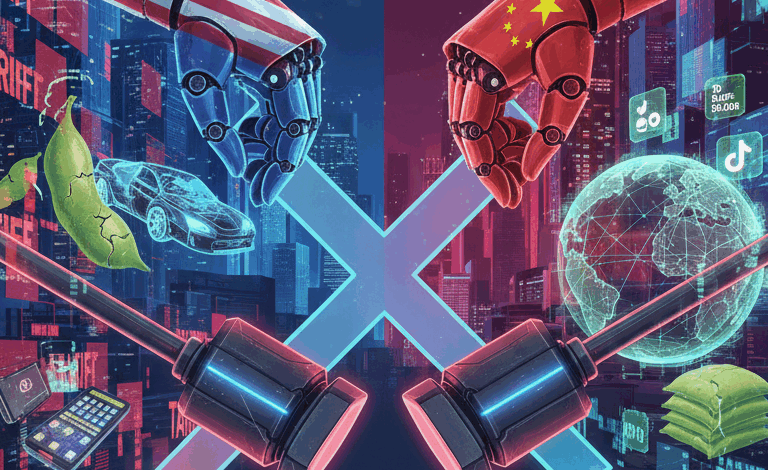
Hey there, ever feel like the US and China have been locked in a never-ending trade battle? You’re not alone! For years, we’ve watched tariffs fly back and forth, hitting everything from soybeans to smartphones. It’s been a dizzying dance of economic brinkmanship, leaving many wondering if there’s any off-ramp in sight.
But hold the phone! Something big just happened in late October 2025: a “framework agreement” that could signal a real break in the clouds. Could this be the moment we’ve been waiting for? Could the infamous “tariff wars” finally be winding down? The implications are far-reaching, potentially reshaping global trade flows and the balance of economic power. Or is it merely a temporary respite? A gilded cage built on shaky foundations? These are the questions swirling in my mind.
Let’s dive into what this new deal actually means for your wallet, global supply chains, and the future of two economic giants. We’ll dissect the details, consider the potential pitfalls, and try to discern whether this is a genuine turning point or just another act in a long-running drama.
A Quick Trip Down Memory Lane: How Did We Get Here?
Believe it or not, US-China trade goes way back to 1784 with the sailing of the “Empress of China.” From tea and porcelain to ginseng, it was a booming business, a testament to the enduring allure of the exotic. It’s fascinating to consider how these early exchanges laid the groundwork for the complex relationship we see today.
Fast forward through some ups and downs (like the Chinese Exclusion Act and a Cold War freeze), and things really took off when China joined the WTO in 2001. Cue the cheaper goods for us, but also a growing US trade deficit and some manufacturing job losses. This period was characterized by a heady mix of optimism and anxiety, as the benefits of globalization were juxtaposed with the disruption of established industries.
Then came January 2018. Enter President Trump, stage left, with concerns about unfair trade practices and intellectual property theft. The “tariff wars” officially began, with tit-for-tat duties escalating dramatically through 2019. We’re talking 145% on Chinese goods and 125% on American goods at their peak in 2025! It’s been a wild ride, a rollercoaster of retaliatory measures that sent shockwaves through the global economy. The trade deficit, a long-standing point of contention, remained stubbornly high, highlighting the limitations of tariffs as a tool for rebalancing trade.
What’s in the New “Framework” Deal?
Okay, so what exactly is on the table in this new agreement, hammered out just before a big meeting between Presidents Trump and Xi? Let’s break it down.
- Tariff Time-Out: The biggest news? The threat of those scary 100% tariffs on Chinese imports that were supposed to hit November 1st, 2025? “Effectively off the table!” Plus, an extension of the current tariff truce. Phew! This provides some much-needed breathing room, allowing businesses to reassess their strategies and potentially lower prices for consumers.
- Rare Earth Relief: China, the world’s rare earth king, has agreed to delay export controls on these critical minerals for a year. Think less stress for our tech gadgets, EVs, and even defense industries. The reliance on China for these vital resources has been a source of vulnerability, and this delay offers a temporary reprieve.
- Soybean Surprises: Good news for American farmers! China’s pledging to make “substantial” purchases of US soybeans again. This is a significant concession, potentially boosting agricultural incomes and easing tensions in rural areas.
- TikTok Tango: Looks like the long-running saga of TikTok’s US sale might finally see a “final deal.” This could resolve a major point of contention, potentially paving the way for greater cooperation on other issues.
- Other Hot Topics: They’re also talking about export controls, tackling fentanyl trafficking (a big win!), and even shipping levies. These are crucial areas of concern, and progress on these fronts would represent a significant step forward in the relationship.
The Skeptics Speak: Why This Isn’t the End (Yet)
While there’s a collective sigh of relief, not everyone’s popping champagne. The path to a truly stable and harmonious trade relationship remains fraught with challenges.
- Economists are wary: Many economists say tariffs largely hurt US consumers with higher prices and ding global GDP. They point out that China’s exports are still strong, just rerouted through countries like Mexico and Vietnam to evade tariffs. The previous “Phase One” deal? China mostly whiffed on its purchase commitments, falling short of promised increases in imports of U.S. goods and services. This casts a shadow of doubt over the current agreement.
- Same old problems: Critics argue this framework, like past deals, doesn’t actually fix the deep-seated structural issues: intellectual property theft, state subsidies, forced tech transfers. It’s more of a band-aid than a cure, addressing the symptoms but not the underlying disease.
- Trust Issues: After years of friction and broken promises, building real trust between the two superpowers is a huge challenge. The scars of past disputes run deep, and it will take time and sustained effort to rebuild confidence.
- Supply Chain Squeeze: Even with rare earth relief, the push for “China-free” supply chains for national security reasons isn’t going away. The impetus to diversify and build resilience in supply chains will continue, regardless of the truce.
Looking Ahead: What’s Next for US-China Trade?
This agreement is a “breathing space,” a diplomatic pause, but the underlying tensions aren’t magically gone. The fundamental differences in political systems and economic philosophies remain.
- Still a tough road: Expect U.S. trade policy towards China to remain “tough” no matter who’s in charge. The bipartisan consensus in the U.S. sees China as a strategic rival, a competitor for global influence.
- Potential future tariffs: Don’t forget, former President Trump has floated even more aggressive tariffs (like 60% on all Chinese goods!) in the past. While this deal provides relief, the threat of future escalation lingers, casting a long shadow over the future.
- Diversifying and De-risking: The U.S. will likely continue its efforts to diversify supply chains away from China, even penalizing transshipments through other countries. The focus will be on reducing dependence and building alternative sources of supply.
- A “New Normal”? We might be looking at a future of managed trade frictions, where immediate crises are averted, but a comprehensive, harmonious relationship remains a distant dream. A pragmatic approach, focused on managing differences and finding areas of common interest, may be the most realistic path forward.
Conclusion
So, could this new US-China trade agreement end the tariff wars? For now, it seems like a significant step back from the brink, averting immediate escalation and offering relief to key sectors. The immediate impact will be felt in reduced uncertainty and potentially lower prices for consumers.
It’s a pause, a truce, a moment to catch our breath. But the underlying competition and complex issues that sparked the trade wars are still very much alive. This agreement is not a resolution, but rather a framework for continued dialogue and negotiation.
The world will be watching closely to see if this framework truly sets the stage for a more stable trade relationship, or if it’s just another temporary ceasefire in a long, ongoing economic battle. The future of US-China trade remains uncertain, but one thing is clear: the relationship between these two economic giants will continue to shape the global landscape for years to come. What are your thoughts? Is this a genuine turning point, or just a temporary reprieve? Let’s discuss.





